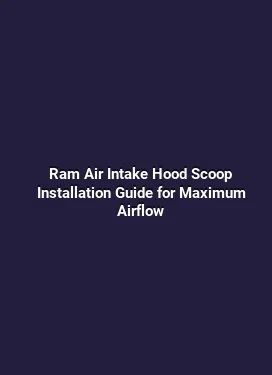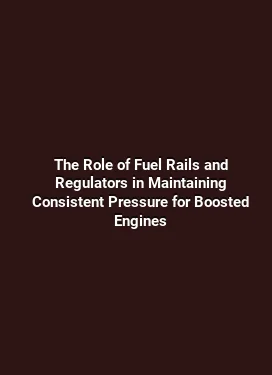How to Size Fuel Injectors Correctly for Your Horsepower Target
Fuel injector sizing is a critical step in aligning an engine’s fueling capability with its horsepower aspirations. This guide walks through the key concepts, practical calculations, and real-world scenarios that help enthusiasts choose injectors that deliver reliable performance without risking lean misfires or excessive fuel when the throttle is wide open. By grounding the process in airflow, engine efficiency, and system limits, you can approach injector sizing with confidence rather than guesswork.
Understanding Injector Sizing and Its Impact on Power

Injector sizing is not about chasing numbers in isolation; it is about matching the engine’s fuel requirements across the operating envelope. The goal is to maintain a safe air-fuel ratio during idle, part-throttle cruising, and high-load operation. An injector that flows too little will starve the engine under boost or high-demand conditions, leading to lean conditions, detonation risk, and power loss. Conversely, an injector that flows too much reduces control over fueling, can cause rich conditions at idle and part throttle, and may burden the ECU with unnecessary duty cycles. The sizing decision hinges on accurate estimations of air mass entering the cylinders and the corresponding fuel mass required to sustain stoichiometric or slightly rich mixtures under target conditions.
The Relationship Between Horsepower Target and Injector Flow Rate

When setting a horsepower target, it is important to translate this objective into an estimated air mass flow. A commonly used starting point is a volumetric efficiency (VE) estimate for the engine at peak power, combined with measured or expected air intake flow. The injector flow rate, often expressed in pounds per hour (lb/hr) or cubic centimeters per minute (cc/min) at a specified fuel pressure, should be capable of delivering the required fuel mass at the engine’s maximum airflow. A practical approach is to determine the required fuel flow at full load and then select injectors with a comfortable margin above that value to cover inefficiencies, variations in fuel pressure, and potential future upgrades such as larger turbochargers or camshaft changes.
Key Variables in Sizing: Airflow, VE, and Fuel Pressure
The core variables involved in injector sizing include how much air the engine can move, how efficiently that air is utilized (VE), the stoichiometric or target air-fuel ratio, and the fuel pressure available to the injectors. Understanding these factors helps ensure the chosen injectors provide adequate fuel delivery without hitting practical limits in the fuel system.
Airflow and VE: The Foundation of Fuel Needs
Airflow is a measure of how much air mass enters the engine per unit time. Real-world airflow depends on engine displacement, RPM, manifold pressure, exhaust restrictions, and forced induction. Volumetric efficiency describes how effectively the engine fills cylinders relative to the theoretical maximum. A naturally aspirated engine with a healthy VE might approach 90-95% at certain RPM ranges, while a turbocharged or supercharged setup can push VE into higher ranges at boost. Knowing the expected peak airflow helps establish the baseline fuel requirement during maximum load.
Fuel Pressure and Rail Capacity
Fuel pressure directly influences injector flow. Most modern engines rely on a specified rail pressure (for example, 40–60 psi for some systems, higher for certain aftermarket setups). The injector atomization quality, spray pattern, and dynamic response depend on maintaining stable pressure. If the fuel pressure is insufficient, injectors can’t deliver the required mass even if their rated flow is adequate at nominal pressure. Rail capacity, line sizes, and pump capability also determine practical limits on how aggressively injectors can be sized for a given horsepower target.
Practical Methods to Size Injectors
Several practical methods exist for sizing injectors that align with a horsepower target. Each method has its own assumptions and levels of complexity. The goal is to arrive at a set of injectors that meet peak load needs with a comfortable safety margin for tuning, while avoiding excessive residual fuel at idle and part-throttle conditions.
Calculation Approach Using Fuel Demand and Duty Cycle
A straightforward methodology starts with estimating the engine’s peak air mass flow at maximum power. This involves a blend of cylinder displacement, RPM, and an assumed VE under peak power. The fuel needed to reach the target air-fuel ratio (AFR) is then calculated. The injector duty cycle—how long the injector remains open each cycle—should remain within a safe range, typically well under 100% at peak power and with some headroom for transient events. A common rule is to target a maximum duty cycle around 80–85% at peak load to keep injector temperatures and spray stability within healthy bounds. If the required duty cycle for a given injector exceeds this range, it is an indicator to step up to a larger flow rate injector.
Using Injector Data Sheets and Real-World Flow Tests
Injector data sheets provide nominal flow rates at specified pressures and temperatures. For sizing accuracy, translate these numbers to the engine’s actual rail pressure. Real-world flow testing, either in a dedicated test bench or via a controlled on-vehicle test, helps capture spray angle, atomization, and part-throttle behavior. When comparing injectors, look beyond peak flow and consider spray pattern compatibility with the intake manifold, injector positioning, and potential fuel slosh in the rail. A well-matched injector will exhibit predictable response and stable AFR across RPM and boost ranges.
Fuel System Upgrades and Considerations
As horsepower targets rise, the fuel system must be capable of delivering consistent fuel delivery under all conditions. This often involves upgrades beyond the injectors themselves, including fuel pump capacity, rail provisions, and line sizing. The objective is to minimize pressure drop and maintain a stable spray at critical moments such as ignition timing events or rapid throttle transitions.
Fuel Pressure, Rail Capacity, and Supply Lines
Upgrading to higher-flow injectors may require an upgraded pump to maintain rail pressure within the desired window. Inadequate fuel supply can lead to pressure drops during surge events, causing lean conditions that undermine power and reliability. Consider daytime reliability, fuel quality, and the potential need for a return-to-tank system to manage pressure spikes and temperature.
Typical Injector Sizing Scenarios and Examples
Concrete examples help translate theory into practice. Consider two scenarios that illustrate how to move from horsepower ambitions to practical injector choices, while accounting for car-specific factors such as turbocharging, NA configurations, cam selections, and intake manifold design.
Example 1: Stock to Moderate Upgrade
For a mid-range NA build targeting around 350–400 horsepower, a well-matched set of injectors might fall in the 440–550 lb/hr range at typical rail pressures. The exact value depends on engine displacement, RPM ceiling, and VE. By estimating peak air mass flow and applying a conservative AFR (for example, 12.5–13.1:1 during full load in many gasoline engines), the required fuel mass can be translated into injector flow. This approach leaves room for minor future upgrades, increased boost, or cam changes without necessitating another injector swap.
Example 2: High Horsepower Target with Forced Induction
A turbocharged engine aimed at 650–750 horsepower may require injectors in the 850–1000+ lb/hr range depending on boost, VE, and fuel strategy. In such cases, a multi-injector approach (multiple injectors per cylinder or a sequential setup) might be used to improve spray quality and ensure reliable mixture formation at high load. It’s essential to verify that the fuel pump, lines, and rails can sustain the required pressure at these higher flows, and that the engine management strategy can keep AFR stable during boost transients.
Tuning and Safety Margins
Fine-tuning is where injector sizing meets real-world behavior. A margin above the calculated peak fuel need helps accommodate variances in fuel quality, ambient temperature, sensor accuracy, and quick-time throttle transitions. An overly tight margin risks lean misfire under sudden load increases, while too large a margin may complicate tuning and waste fuel. The tuning process also involves idle stability, startup enrichment, and wide-open-throttle enrichment that works synergistically with injector timing and fuel pressure control.
Duty Cycle Safe Ranges, Idle, Startup, and Wide-Open Throttle
A practical duty cycle target at peak power is often in the 75–85% range for reliable operation across most setups. At idle and light load, the duty cycle should drop significantly to maintain stable idle behavior and clean emissions. During startup, enrichment strategies ensure quick light-off without flooding. Wide-open throttle conditions demand robust spray coverage across the intake to prevent lean pockets and to preserve peak power. Maintaining a comfortable margin in the duty cycle across the engine’s operating envelope helps sustain consistency under track or street use.
Common Pitfalls and Troubleshooting
Injector sizing mistakes are common, especially for enthusiasts venturing into forced induction or large-displacement builds. Recognizing the signs early helps avoid costly detuning or failures.
Symptoms of Undersized vs Oversized Injectors
Undersized injectors typically present as lean spikes under high load, right-footed acceleration that stumbles, or a failure to achieve target AFR at boost. Oversized injectors may make idle and part-throttle tuning more challenging; the engine may run rich at light loads, and the control system can struggle to reach a clean idle or transition smoothly to boost. In both cases, data logging AFR readings, fuel pressure stability, and injector duty cycle diagnostics are essential to diagnose the root cause and guide adjustments in fuel maps or hardware upgrades.
Practical Tips for Achieving Consistent Results
Achieving reliable fuel delivery involves a combination of well-chosen injectors, proper fuel pressure management, and careful tuning. Start with a solid baseline that reflects known good configurations for similar builds and adjust from there. Consider using a fuel pressure regulator suitable for the intended flow range, verify pump temperature limits, and maintain clean filters to avoid fuel delivery interruptions. Real-world testing on a dyno or a controlled track environment provides the best feedback to refine injector sizing and tuning maps.
Integrating With Intake and Fuel System Upgrades
Injector sizing should be considered in concert with intake manifold design, throttle body sizing, and turbocharger or supercharger selection. A well-integrated system ensures uniform air distribution to cylinders and consistent fuel delivery. In some builds, upgrading to a high-flow intake manifold and precision fuel rails complements injector upgrades, reducing pressure losses and enabling more predictable engine response across the RPM range. The synergy between air handling and fuel delivery is the backbone of a reliable, high-performance setup.
Maintaining Long-Term Reliability
Consistency in fuel delivery supports not only peak power but longevity of components such as fuel pumps, lines, and seals. Regular maintenance—fuel filter replacement, pump health checks, and rail cleanliness—helps protect injector performance. For turbocharged or supercharged engines, monitoring fuel rail temperature and ensuring temperature compensation in the ECU helps prevent spray instability under sustained boost. Thoughtful planning around injector sizing, fuel system upgrades, and tuning practices yields a setup that remains responsive and dependable over time.
Advanced Considerations for Different Build Paths
NA engines, turbocharged builds, and supercharged applications each present unique challenges in injector sizing. NA engines rely more on VE and volumetric efficiency, while forced-induction platforms must account for boost-induced air mass. Camshaft selection, intake runner length, and exhaust flow all influence the optimal injector flow rate. In some scenarios, staged injector strategies or sequential injection can improve throttle response and emissions control without sacrificing peak power. Evaluating the entire fueling system as an integrated package tends to yield the most predictable outcomes across driving scenarios.
Real-World Testing and Data-Driven Tuning
After selecting injectors, collect data across a broad range of RPM and load. AFR targets should remain stable under steady-state and transient conditions, and the engine should respond predictively to throttle input. Logs that capture AFR, injector duty cycle, fuel rail pressure, and fuel temperature provide a clear picture of system health. Use this data to adjust fueling maps in small increments, validating each change with repeatable measurements to avoid over-tuning and ensure consistent performance.






